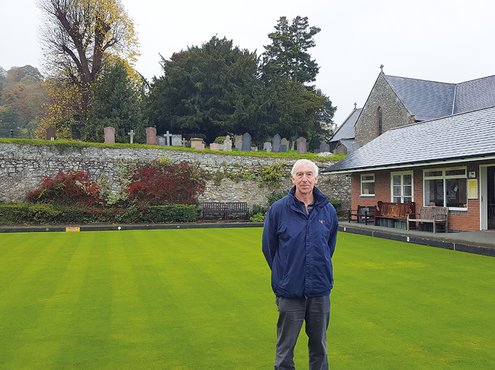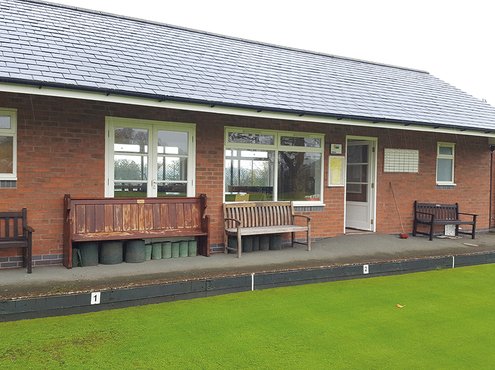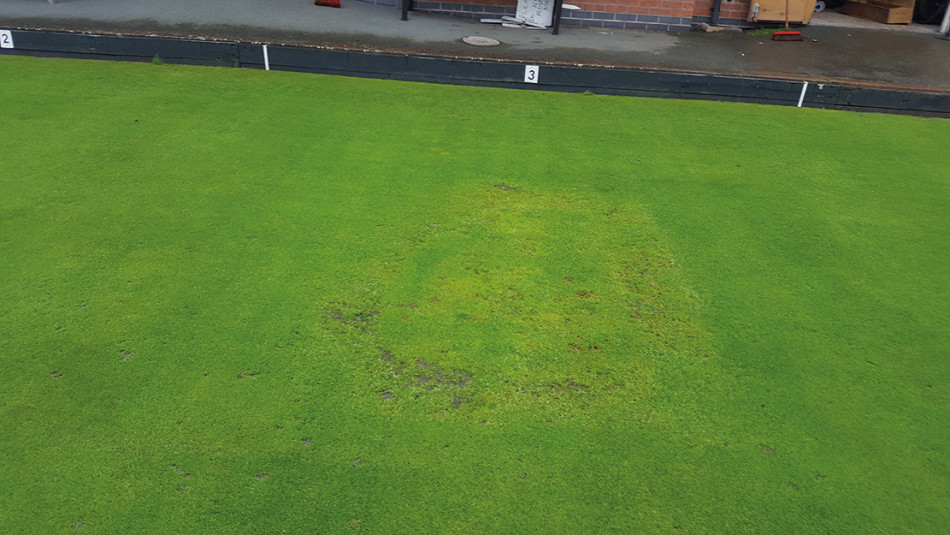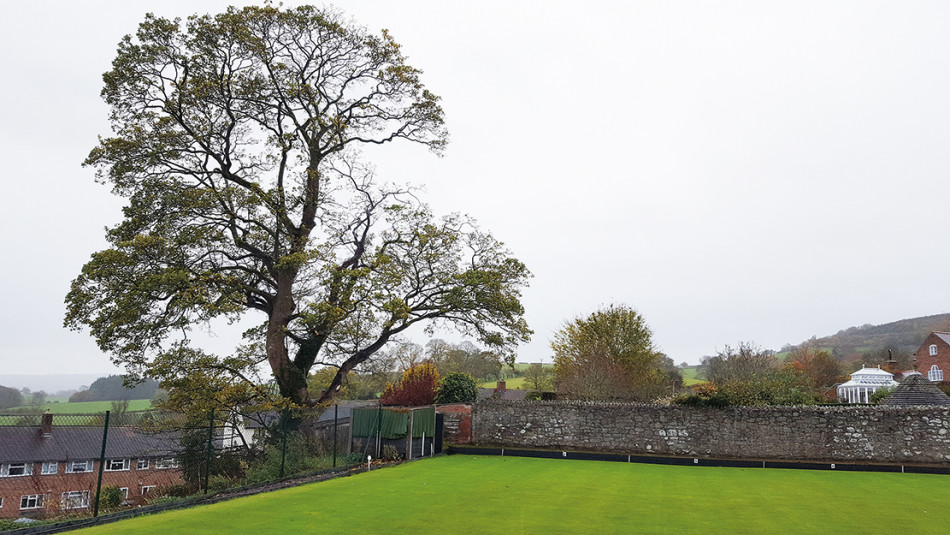Montgomery Bowling Club - Beloe; above and beyond...
Montgomery is a town in the Welsh Marches, administratively in the Welsh county of Powys. It is the traditional county town of the historic county of Montgomeryshire, to which it gives its name. The town centre lies one mile from the English border, as does Montgomery Bowls Club, which is bounded on two sides by the town's historic stone wall
Michael Beloe, 70, looks after the green at Montgomery Bowling Club, right on the Welsh-English border. His background isn't in turfcare; rather, he was a teacher - but he knows his stuff. In his own words, the following outlines his work on this small and historic green.
"Our surface is 31.2 by exactly 30 metres, so it's under 1000m2. A competition green would be around 1500-1600m2. But it's been here since 1773, so we really can't make it any bigger.
That's the town wall there on the left [he pointed to the eastern edge of the pitch, then to the south, then the west]. That's somebody's garden, and that's the road. So, we're locked in. At least, that used to be the town wall. It's now a protected site, so we can't go into it anyway.
I came here in 2006, as a bowler. I used to manage another bowling green not too far away, and had already completed my Level 1 greenkeeping course in Port Talbot, so was set up to take over the green as well as play on it.
Before that, however, I had no experience of turf maintenance. I hadn't played bowls before either. The first time I played bowls was twelve years ago in 2005.
Now, I play for the county veteran's side, for which we travel Wales a lot. That gives us the chance to view many greens, some of which are quite challenging. And I was driven to build the surfaces by wanting to play on good surfaces myself.
When a bowler visits a club like the Welsh Centre of Excellence base at Llandrindod Wells, their bowls do exactly what they say they're going to on the packet.


When they visit a site that isn't cared for, they find it hard to adjust to the woods not doing what they're told, or at least I do. So, I always want to make the best surface I can for the money.
At my previous club, they had quite a bit of kit by the standard of these places, but nobody to use it. So, I took over and, over the two years I was working there, it improved dramatically, mainly because I went on that course to learn what to do with it all.
When I got here, they were maintaining the surface in the most traditional way; just cutting it once or twice a week, but then leaving it uncut all winter.
So, it became very long - perhaps up to 30/40mm.
Then, they'd come back in the spring to cut it, and wonder why it went into shock and turned yellow; why it was so poor. And it was a rough, poor surface when I came to play on it.
The first thing I did was bought them a Dennis mower with all the attachments. That was a £7,500 gift from my own money. They didn't have a spiker either, so I bought one of them too.
I've invested about £10,000 into this out of my own pocket, because you can't have a proper green without a mower and other basic equipment.
One reason for that input is: it's pointless playing on a surface if it isn't a good one. I get annoyed when we travel to bowling clubs where they don't produce a decent surface on which to bowl.
Like any sport, if the surface isn't good, no matter how good you are, you can't play the game you're there to play.
That's why I'd always take a surface that plays well over one that looks nice. The reason I bought the Dennis is it has a verti-cutter, for which you can take the cassettes out and replace them. That, the ability to verti-cut it heavily, has been the single biggest factor in this pitch's improvement.

I do that all the way through the summer, maybe every fortnight or every week. Each time, I remove six barrow-loads of grass, and you can't see that you've done it. But, it makes the grass grow vertically, then when the woods roll on top of the blades, it gets faster. It's a wonderful machine.
I've worked with other companies before my current account manager at ALS, Chris Knowles, who has only just recently joined the company, and have put together a proper series of food nutrition for the green with his help.
That's because this is a very poor surface, in terms of its make-up. It is, believe it or not, constructed out of material from the Shrewsbury Bypass. And that goes all the way down.
About thirty years ago, a firm came in to renovate the green, they removed the top surface and then walked out of the job, leaving the club to totally remake the green.
So, they took lorry loads of soil from the road, and tipped it over that [the western] wall. And they spread it, without even sieving it. There were stones and rocks in it, and still are.
There are no drains. There is a cinder base to it, but that's the original base. As you can imagine, some of the soil from the bypass is quite clay-based, so we do have a problem with it being moist, hence we have an ongoing problem with fusarium.
In that sense, I suppose it is a good thing that we're on a hill. Some of it does disappear out from there … eventually.
We have spent a huge amount of money on feeding it, and trying to improve the quality of that soil, insofar as it should hold more nutrients, and hold more microorganisms.
We've stopped using iron sulphate, for example, on the recommendation of Chris, who had taken a sample from the green.
The green, we found, is very healthy in most respects, save for two key areas: it has a pH of 4.7, which is very low indeed; and it has a higher iron content than it should.

That is because they used to use granules of iron sulphate to control moss, which is of course residual, and it just builds and builds until the surface is no longer balanced properly.
Before talking to Chris, I was using soluble iron, which is the same stuff as the granules really, to control moss, toughen the grass and control disease.
Now, I've moved onto chelated iron, to reduce the level of iron in the green. And aids like that are all part of the science of what we do, which I'm learning about, but would love to learn more about.
I've tried, in fact, to get access to a Level 2 course to improve my knowledge of that science, but they don't hold them around here. They only hold them in England.
That training organisation couldn't help me with my green in person, and they very rarely, if ever, publish articles or information on looking after a bowling green.
That led me to leave my membership of the organisation which was providing my qualifications, and to ask for Chris's help, because he covers a wider area.
I also wanted to gain my spraying certificates but, because I tend to need to pay for training and equipment myself, I couldn't afford to.
Very luckily, a member of our small club just happened to already have the qualifications, so he can do the spraying for us whenever we've got the equipment at hand.
So, overall, this is a non-stop job, for which I obviously don't get paid. In fact, it's probably cost me an average of £500 per year.
I've cut it specially for your visit. You can see it's double-cut, on direction was yesterday with a Ransomes mower, which is perfectly suitable during the winter work, although it isn't fine enough to carry on later. The Dennis is a much more versatile machine.
As everyone is, we are plagued with worms, as you can see. But, we don't go down the road of oil-based products - and ALS are strictly with me on that decision. We don't use such harmful products in the surface, and will continue not to.
Worms are hermaphrodites, and produce eggs three or four times per year, so even if you're successful with those products, they come straight back again anyway.
Right by the green there are nests of robins and pied wagtails, which don't cause any harm to the surface at all. It's a help, actually, when they come and take away some of the grubs.
We don't get crows, magpies, or any other of the corvids. As far as I know, we don't get any larger pests at all. We have treated it with Chlorpyrifos which will, of course, now be Nemasys next time we treat, since the former is no longer available.


On that note, I'm going to try to go as organic as I possibly can from now on. The chicken-based product called 'Organo' [Maxwell Turf Organic Fertiliser 16-3-8 +2MgO +1Fe] is one I've already taken up.
I used it in the summer, and it was wonderful. It lasted for ten weeks. It's very fine-grain, so it sinks straight in, and you see the green look healthy within ten days of it going on. I'm going to get more of that next year, after I've used up the last of my liquid feed supplies.
But, primarily, I'm going to go down the route of using HumiMax and Turf Hardener, to increase the take-up of the other products I put into the green.
That's because I'm a progressive. I hate the phrase "we've always done it this way", because this is a science-based practice, and it follows that new products and services work, and that there should always be new ways to tackle problems.
I use a lot of seaweed. I probably spray a litre of seaweed every week, in two halves. For that reason, it's nice to have a small green, because it really keeps costs down with products I like to use a lot.
We probably spend about £1500 on the surface a year, of which around £900 is autumn work; to scarify and re-seed it.
Most of the rest of the money for feeding and preventatives comes from a Sunday lunch which raises over £1000 to spend on the green.
You can see from here that disease is a major problem. It always has been. That's mainly because it's enclosed by these stone walls.
The major prevailing wind is from the west, which is totally blocked out by the wall. And if it comes from the east, that's a cold wind, so it doesn't help either.
This green is always attacked by fusarium in October/November, and then again in March. I'm going to use the Dualitas, which must be well-timed.
You need to plan it for a couple of days without rain, so it can be fully absorbed instead of rinsed.
I've had dollar spot - a huge outbreak of dollar spot, I've had red thread, and if you'd come last year, you would have seen the western side of the surface barren.

We had to take it up, because we were afflicted by take all patch. I had to dig to 300mm and rebuild it completely. It was horrendous; destroyed one of our best rinks. That took three years to recover, which highlights the importance of these preventative measures.
Now, the quality of the grass is rather good. It has three types of grass in it. It's got ageing rye grass, as well as a more recent bent and fescue 30/70 mix, which is excellent.
And I buy quality, expensive grass seed, because I was sold some Johnson's J Premier Green as a one-off, and after it helped massively, it was too hard to go back. I have now switched to another premium seed, however - the Limagrain MM10.
I used that this year, and it germinated even with the awful weather in which we sowed it. Five weeks ago, we had bare patches all along the edges, and there's been take-up all over.
That said, I have robbed Peter to pay Paul. I've taken some turf from the overlap and introduced it to some of the struggling areas.
The main problem on a green this small is that we can't move the players around between the rinks. It's a matter of over use, because the rinks are the minimum size you're allowed at 4.2 metres each, and we can't make them any wider, because they just wouldn't fit.
I have a helper in the summer who cuts the green, but that's the extent of the help I get. And, as you can see, my family have come down today to help with the cutting of these bushes at the edge of the green.
I'd also like to cut down this 50ft sycamore [in the south-east corner], because it casts enough shade to make the southern edge of the surface about five degrees Celsius colder than the rest. And then there's the issue of all the leaves falling.
I've also made that argument on safety grounds. Not long ago, a huge branch fell down that hill there [east], which is where the children walk to school. Had it happened at the wrong time, someone could have been seriously hurt.
There are two large lime trees too [west]. The sun travels past the sycamore, then the walls, then the lime trees, and by 7.00pm at the height of summer, we've had all the light we're going to get.
What that also means is that the western side of the green will stay frozen for the entire duration of a frost, including during the daytime. I've seen that area frozen solid for two-to-three weeks.
The frosts are great, of course, but it really freezes that end, and what that means is that, if I don't come to clear the dew every morning, it becomes very wet. That makes it even more perfect for disease in the long run.

It's a green with lots of issues, and it takes a lot of looking after. From me, that's about ten hours per week in summer and three in winter.
I regard it rather like a temperamental adolescent. It has its moods, and you can't abuse it or mistreat it, because it will bite you back if you let it down.
I'm used to managing difficult young people too, because I was a teacher for thirty-five years in a large comprehensive school.
I started teaching in 1969, and absolutely loved it. You got to work with children, see the good you were doing, take them on trips and whatever else was needed. You know, you could teach them.
Then, gradually, as the National Curriculum came in and I switched from PE to pastoral, then retrained and switched again to Design and Technology, and teaching changed too.
And because I didn't like the way it was changing, I spent the
final eighteen years of my career teaching teachers how to teach
D&T properly.
What destroyed the whole system was the target-setting, and the
idea that it was better to push children through a standardised
hoop than to teach them things.
My GP told me "you can either retire early or die early", so I walked away at fifty-seven. And now I spend my life trying to do other things. So, I came to Wales to help my daughter where she already lived. And I started bowling and tending the greens. It's been lovely.
I was a pupil at The Perse School, Cambridge, hence my love of sport. It had remarkable facilities. That's where my regard for good quality sports facilities originated, I think.
Although, it was also helped because I played high-level cricket when I was a teenager. I played for Norfolk, where I lived. I nearly turned professional.
We had the most wonderful cricket square that was well looked after. And that was good for me as a fast bowler, and sparked my interest in playing on proper surfaces.
And when I stopped work, I needed something to do as well as raising my two grandchildren. It became a useful outlet for me.
It can be frustrating when people don't fully appreciate the work and/or money you put in. People do come on here and lob the woods from a foot high and take divots.
Sometimes, it looks as though someone's been on here with a pitching wedge, which I must admit breaks my heart a little bit, watching them chuck their size 4s hard down. I use golf pitch mark repairers, which tells you the damage that can be done.
But, I do enjoy it. I will keep doing this for as long as my body is willing and able, because there's nobody else who will do it.
When I do give this up, I will have to train someone to do what I do, because otherwise it will regress very quickly.
I can't do it indefinitely, but if I stop, all my hard work will be undone. And I just couldn't live with watching that happen."
The products mentioned in this article are available from the Pitchcare Shop
